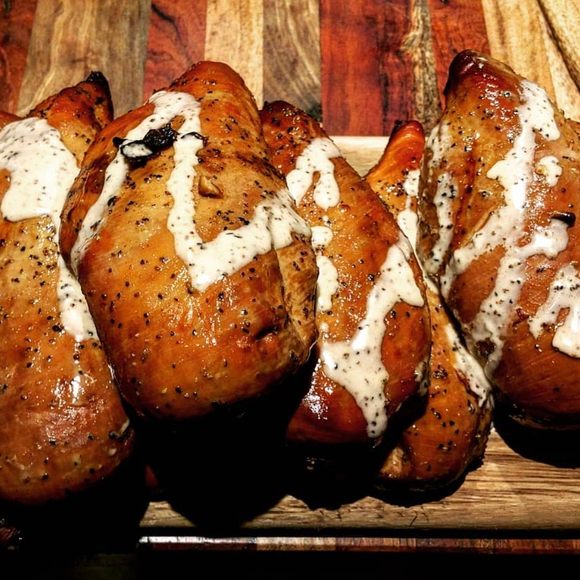Around the world, barbecue-eating rituals are a saucy mess. But in Alabama, digging into a pile of meat won’t leave you with the usual streaks of mahogany smeared across your face (or dripping down your chin, or running up the side of your cheek—at which point, it’s probably also in your hair). The Cotton State’s signature sauce is as white as the fiber for which it’s nicknamed.
While styles of barbecue vary from state to state, American fans tend to expect a tomato-based condiment. Alabama white barbecue sauce gets its uniquely pale and creamy disposition from mayonnaise. Four other ingredients round out the basic recipe: apple cider vinegar, lemon juice, salt, and coarse-ground black pepper. Like most red and brown sauces, the topping gives meat a tangy, savory kick. But because of the high fat content, it also imparts a permeating richness.
Visitors might mistake it for carrot dip, but pitmasters in the Heart of Dixie have been baptizing whole chickens in all-white since long before the days of ranch dressing. “Big” Bob Gibson (at 6-foot-4 and 300-pounds) is the man behind the state specialty. During the week, he worked on the L & N (Louisville and Nashville) railroad; on weekends, he barbecued for friends and family from his hand-dug pit in his backyard. In 1925, he founded Big Bob Gibson Bar-B-Q in Decatur.
Bob’s sauce was vinegar-based, but it included mayonnaise. A lot of mayonnaise. Why? The restaurant’s current executive chef thinks it’s because the added fat helps maintain the meat’s moisture as it’s slow-cooked. “His chickens sometimes stayed on his pit for three hours,” says the chef, adding “you’ve got to have some way to keep those chickens moist.”
Over ninety years later, the formula is still going strong. The establishment has a second location, a trophy case filled with awards, and a state’s worth of eateries that followed suit. The sauce began as a baste, but has since evolved into a table condiment and dip, especially for smoked poultry, fried chicken, and pulled pork. And while it’s considered a state-wide phenomenon today, originally, Alabama BBQ joints took their cue straight from Big Bob.
Where to Try It
-
Big Bob Gibson Bar-B-Q
1715 6th Ave SE (US Highway 31), Decatur, Alabama, 35601, United StatesFounded in 1925, this Alabama institution that made made white sauce famous now has two locations.
-
This hole-in-the-wall has been slinging "Kickin' Chicken White BBQ Sauce" in the Nashville area for over 25 years.
Written By
 rachelrummel
rachelrummel
Sources
- southernbite.com/alabama-white-bbq-sauce/
- www.bigbobgibson.com/
- www.encyclopediaofalabama.org/article/h-1405
- www.southernliving.com/food/how-to/a-north-alabama-favorite-white-bbq-sauce
- www.bonappetit.com/recipe/white-barbecue-sauce
- www.seriouseats.com/recipes/2012/07/alabama-white-barbecue-sauce-recipe.html
- www.thespruce.com/alabama-white-barbecue-sauce-333688
- www.al.com/entertainment/index.ssf/2017/10/alabama_white_barbecue_sauce_b.html



















